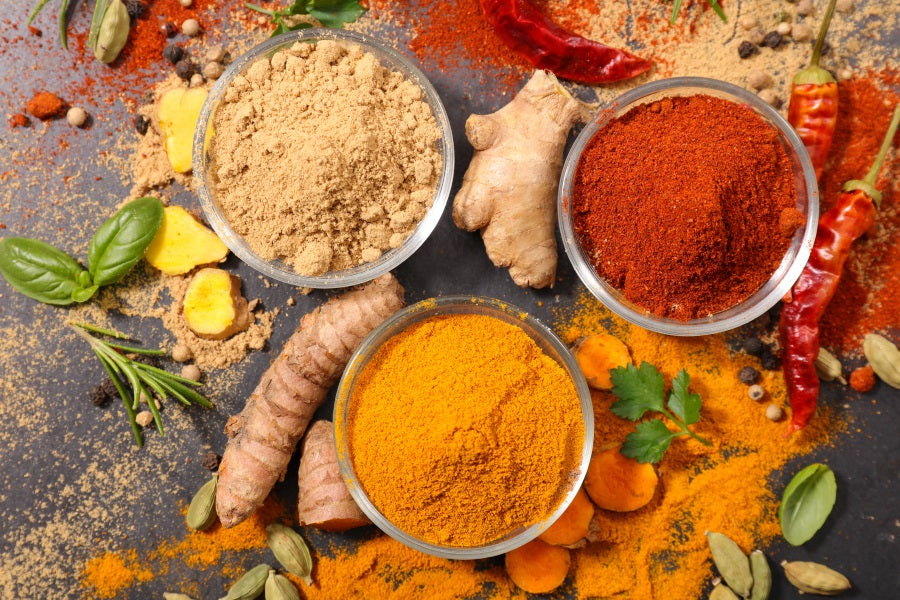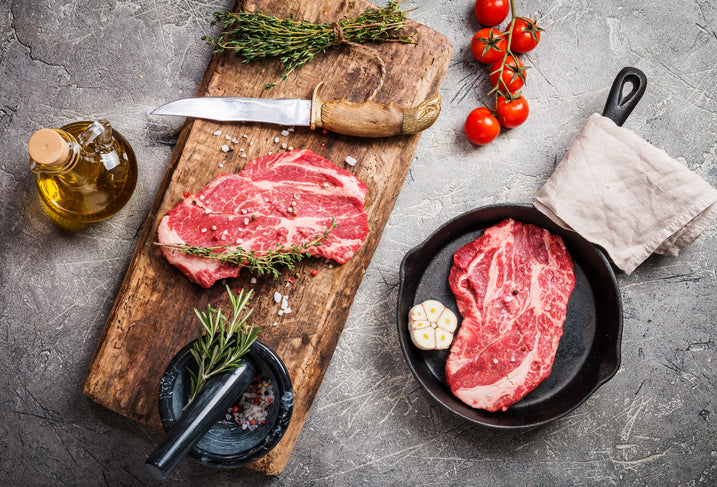
7 Anti-Inflammatory Herbs and Spices
Yes, I know I say it all the time. But I’m going to say it again: The best medicine isn’t in your medicine cabinet, it’s in your pantry!
And guess what: Some of the most powerful medicine comes in the smallest packages. I’m talking here about herbs and spices, which can have a big effect on your health even when you use them in tiny amounts. Think of your spice rack and your herb garden as a natural pharmacy.
In particular, many herbs and spices have amazing anti-inflammatory effects. Here are some of the seasonings you should definitely have in your kitchen if you’re serious about kicking inflammation out of your life.
Turmeric
If you aren’t familiar with turmeric, it’s the warm, peppery spice that gives curry its yellow color—and when it comes to fighting inflammation, it has superpowers.
Much of turmeric’s magic comes from the curcumin it contains. Research shows that curcumin is a huge inflammation fighter.
A 2015 study, for instance, focused on the effects of curcumin on metabolic syndrome. (Metabolic syndrome is a combination of excess belly fat, high blood pressure, high blood glucose, and unhealthy cholesterol and triglyceride levels, and it’s linked to high levels of inflammation.)
In the study, researchers asked 117 people with metabolic syndrome to take either curcumin supplements or a placebo every day for eight weeks. They measured C-reactive protein (CRP) and two other markers for inflammation before and after the experiment, and discovered that curcumin lowered all three markedly.
That’s just one of dozens of studies highlighting the anti-inflammatory effects of curcumin. Other studies show that it helps fight everything from gum disease to joint pain to cardiovascular disease.
Because curcumin makes up only a small part of turmeric, many people take curcumin in supplement form. That’s a good idea, especially if you have diabetes (because curcumin also lowers blood glucose). But I recommend using turmeric as well, because—in addition to its curcumin content—this spice has other components with anti-inflammatory, antibiotic, cancer-fighting, and antioxidant properties. That’s why I include it in my Bone Broth.
Want more ways to get the benefits of turmeric? Use it in curries, sprinkle it on eggs or avocados, or make an ancient healing drink called “golden milk”. Whenever possible, eat turmeric along with black pepper, because the piperine in black pepper makes the turmeric up to 2,000% more “bioavailable”!
Cloves
Cloves are one of my favorite spices, because they’re cute as a button—and what would the holidays be without their delightful scent? Moreover, they contain eugenol, a potent anti-inflammatory. Like drugs such as Celebrex, eugenol is a COX-2 inhibitor.
Think of cloves and you think of baking, but they’re good for so much more. I add ground cloves to butternut squash soup and pumpkin smoothies—and needless to say, ham and cloves are a great combo. You can also make clove tea by adding a tablespoon of ground cloves to a quart of filtered water and letting the mixture steep for 20 minutes before straining out the cloves with cheesecloth. (Add a touch of honey or stevia if you’d like.)
Cinnamon
This warm, fragrant spice also conjures up memories of the holidays—and that’s not the only reason to love it. It’s also high in cinnamaldehyde, which has powerful anti-inflammatory effects. Research shows that cinnamaldehyde can do everything from protecting against cardiovascular disease to inhibiting h. pylori infection.
Cinnamon is fabulous in smoothies, shakes, and soups, but you can also use it in savory dishes.
Cayenne
It may seem surprising, but fiery cayenne can help put out the fire in your gut! That’s because it’s rich in capsaicin, a potent anti-inflammatory substance. Capsaicin affects the gut in ways that protect against ulcers. It’s also an inhibitor of substance P, a neuropeptide associated with inflammatory processes.
It’s easy to incorporate cayenne into your diet. In addition to adding it to soups, stews, and curries, sprinkle it on veggies and eggs, and even try it in green drinks. If you’re not used to cayenne, start slowly and see how much you can handle.
Basil
As an Italian, I couldn’t live without basil! I use fresh basil in everything from pesto to soups to salads, and I love dried or fresh basil in tomato sauces.
Like cloves, basil is rich in eugenol—so while I love how it tastes, I’m even more crazy about its anti-inflammatory power. It’s also easy to grow, both indoors and out, so you can always have fresh basil handy.
Rosemary
Rosemary is known as the herb of remembrance—and interestingly, one study showed that simply sniffing rosemary oil can temporarily improve your memory! More importantly, research shows that rosemary has anti-inflammatory powers.
Rosemary pairs beautifully with roast chicken, salmon, beef roasts, or even beets, and I also love it in bone broth. This is another herb that’s easy to grow, so try keeping some on your windowsill.
Ginger
Ginger is loaded with gingerols—and these natural chemicals, in turn, are packed with anti-inflammatory power. Ginger can lower inflammation throughout your body, and in particular it’s fantastic for your joints.
To get more ginger in your diet, add it to smoothies, veggie dishes, and salad dressings. You can also make a ginger tea by steeping a little grated ginger in water and adding a touch of honey or stevia. Check out this recipe from my new cookbook, contributed by Good Morning America chef Karen Pickus.
Ginger-Poached Asian Pears with Coconut-Cardamom Cream
These pears simmer gently in a vanilla-and-spice bath. When they’re tender, you’ll drizzle them with syrup and top them with a dollop of the cream.
Prep Time: 5 minutes | Cook Time: 45 minutes | YIELD: 4 servings
INGREDIENTS
- 1⁄2 vanilla bean
- 8 slices fresh ginger (each 1⁄8-inch thick)
- 8 whole cloves
- 2 cardamom pods
- 1 cinnamon stick
- 1 star anise
- 2 Asian pears, peeled, halved, and cored
- 1⁄3 cup coconut cream (see Tip)
- 1⁄4 teaspoon ground cardamom
- 1⁄8 teaspoon ground ginger
DIRECTIONS
In a medium saucepan, combine 3 cups water, the fresh ginger, cloves, cardamom pods, cinnamon stick, and star anise. Split the vanilla beans and scrape the seeds into the pan, and throw in the vanilla pod. Bring to a boil, reduce the heat to medium low, and add the pears. Cover and simmer, turning the pears occasionally, until a paring knife slides easily into the thickest portion, 25 to 30 minutes.
Remove the pears to a dish and cover with foil. Strain the spices out of the poaching liquid and return the liquid to the pan. Bring to a gentle boil over medium-high heat and cook until the syrup is reduced to 1⁄2 cup, about 20 minutes.
Meanwhile, in a medium bowl, with an electric mixer or a whisk, beat the coconut cream, ground cardamom, and ground
ginger until thick.
To serve, spoon the syrup over the pears and dollop with the spiced cream.
Tip: Coconut cream is available wherever canned coconut milk is sold. If you can’t find it, chill a can of regular full-fat coconut milk and scoop out the solid white part that solidifies at the top.
How to “power up” your herbs and spices
As you can see, herbs and spices pack a lot of anti-inflammatory power into a tiny package. Here are a few tips for maximizing that power:
- Keep dried herbs and spices fresh. To do this, buy them in small quantities, or buy them in bulk and freeze them. If possible, replace your spices every year.
- Keep dried herbs and spices in a dark, dry place, and avoid putting them close to the dishwasher or the oven because the humidity and heat are bad for them.
- If you buy your herbs and spices in bags, keep the bags sealed as tightly as possible. If you buy them in jars, don’t open the jars until you’re ready to use the spices.
- Buy the highest quality organic herbs and spices you can find. Low-quality spices can be loaded with contaminants you don’t want.
- If you’re a serious cook, buy spices whole and grind them yourself. Whole spices keep fresh much longer than ground ones.
Also, get adventurous with spice blends. For instance, try classic spice blends such as Chinese five spice and Ras el Hanout. The spices in blends like these work synergistically, giving you even more healing power. Just check the labels and make sure that spice blends contain only spices—not additives like sugar or MSG.
Above all, think of ways to work herbs and spices into every meal—not just dinner. Each day, see how many new foods you can add them to—from eggs to bone broth to salad dressings to smoothies. The more anti-inflammatory spices you add to your diet, the more delicious—and healthy—it will be!
Keep thinking Big and living BOLD!







